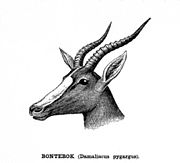
Bontebok
Encyclopedia

Antelope
Antelope is a term referring to many even-toed ungulate species indigenous to various regions in Africa and Eurasia. Antelopes comprise a miscellaneous group within the family Bovidae, encompassing those old-world species that are neither cattle, sheep, buffalo, bison, nor goats...
found in South Africa
South Africa
The Republic of South Africa is a country in southern Africa. Located at the southern tip of Africa, it is divided into nine provinces, with of coastline on the Atlantic and Indian oceans...
and Lesotho
Lesotho
Lesotho , officially the Kingdom of Lesotho, is a landlocked country and enclave, surrounded by the Republic of South Africa. It is just over in size with a population of approximately 2,067,000. Its capital and largest city is Maseru. Lesotho is a member of the Commonwealth of Nations. The name...
. The Bontebok has two subspecies
Subspecies
Subspecies in biological classification, is either a taxonomic rank subordinate to species, ora taxonomic unit in that rank . A subspecies cannot be recognized in isolation: a species will either be recognized as having no subspecies at all or two or more, never just one...
; the endangered Bontebok (Damaliscus pygargus pygarus), occurring naturally in the Fynbos
Fynbos
Fynbos is the natural shrubland or heathland vegetation occurring in a small belt of the Western Cape of South Africa, mainly in winter rainfall coastal and mountainous areas with a Mediterranean climate...
and Renosterveld areas of the Western Cape, and the Blesbok
Blesbok
The Blesbok or Blesbuck is an antelope with a distinctive white face and forehead. Its white face is the origin of its name, because bles is the Afrikaans word for bald...
(Damaliscus pygargus phillipsi) occurring in the highveld
Highveld
The Highveld is a high plateau region of inland South Africa which is largely home to the largest metropolitan area in the country, the Gauteng City Region, which accounts for one-third of South Africa's population.-Location and description:...
.
The Bontebok stands 80 to 100 cm at the shoulder and weighs 50 to 90 kg. The Bontebok is a chocolate brown colour, with a white underside and a white stripe from the forehead to the tip of the nose, although there is a brown stripe across the white near the eyes in most Blesbok. Bontebok also has a distinctive white patch around its tail (whence the Latin name), while this patch is light brown/tan in Blesbok. The horns of Bontebok are lyre-shaped and clearly ringed they are found in both sexes and can reach a length of half a metre.
Blesbok live in highveld where they eat short grass
Grass
Grasses, or more technically graminoids, are monocotyledonous, usually herbaceous plants with narrow leaves growing from the base. They include the "true grasses", of the Poaceae family, as well as the sedges and the rushes . The true grasses include cereals, bamboo and the grasses of lawns ...
es, while Bontebok are restricted to coastal Fynbos and Renosterveld (Skead, 1980). They are diurnal
Diurnal animal
Diurnality is a plant or animal behavior characterized by activity during the day and sleeping at night.-In animals:Animals that are not diurnal might be nocturnal or crepuscular . Many animal species are diurnal, including many mammals, insects, reptiles and birds...
, though they rest during the heat of the day. Herds contain only males, only females or are mixed and do not exceed forty animals for Bonteboks or seventy for Blesboks.
Bontebok are not good jumpers but they are very good at crawling under things. Mature males form territories and face down other males in displays and occasionally combat.
Bontebok were once extensively killed as pests
Pest (animal)
A pest is an animal which is detrimental to humans or human concerns. It is a loosely defined term, often overlapping with the related terms vermin, weeds, parasites and pathogens...
, and were reduced to a wild population of just seventeen animals, but the species has since recovered. Blesbok are extinct in their natural habitat
Habitat (ecology)
A habitat is an ecological or environmental area that is inhabited by a particular species of animal, plant or other type of organism...
but they have increased in population to the point where they are now very abundant and avidly farm
Farm
A farm is an area of land, or, for aquaculture, lake, river or sea, including various structures, devoted primarily to the practice of producing and managing food , fibres and, increasingly, fuel. It is the basic production facility in food production. Farms may be owned and operated by a single...
ed, because they are popular quarry for hunters and are easy to sustain.

